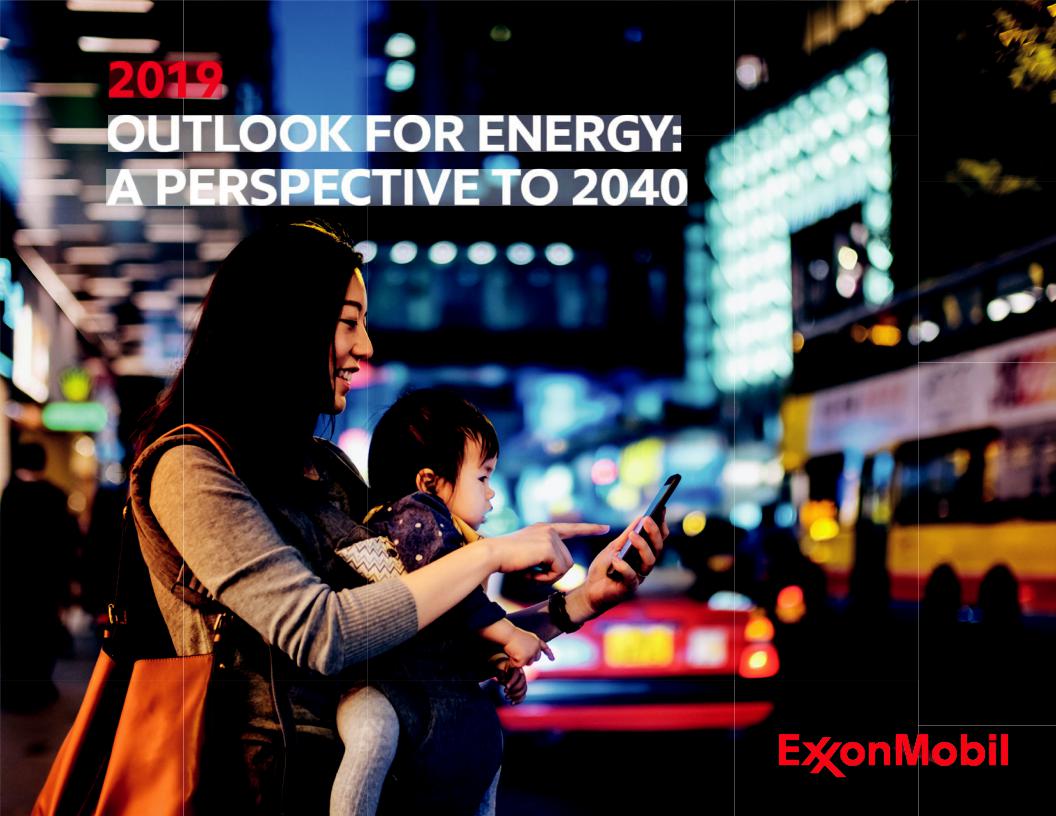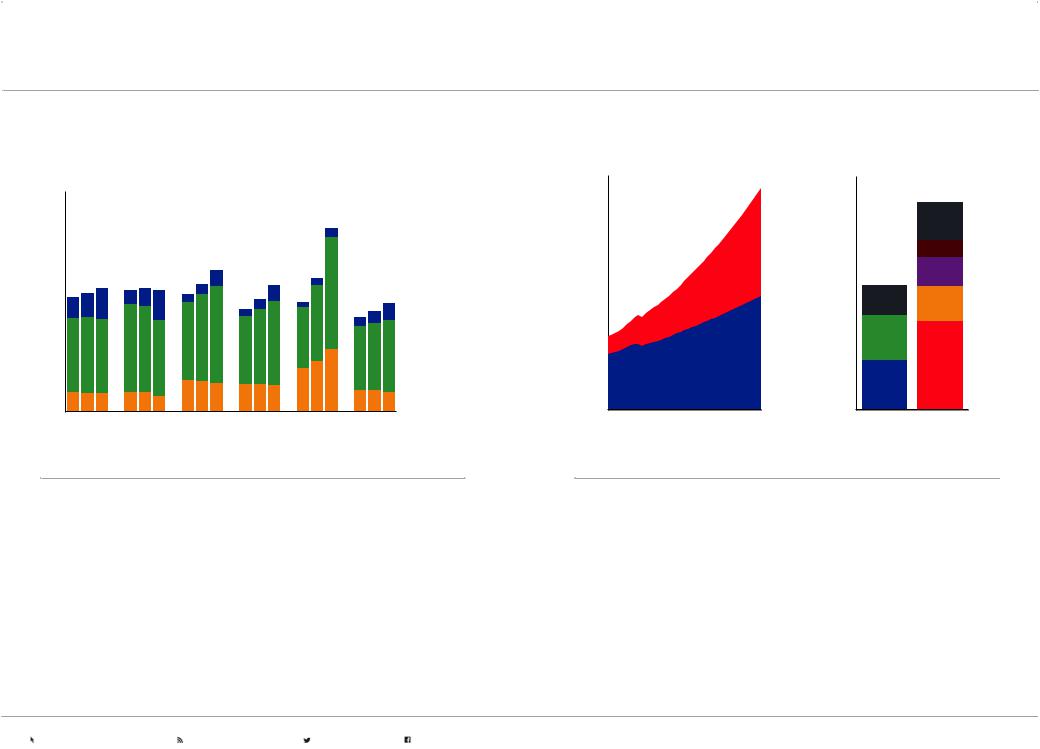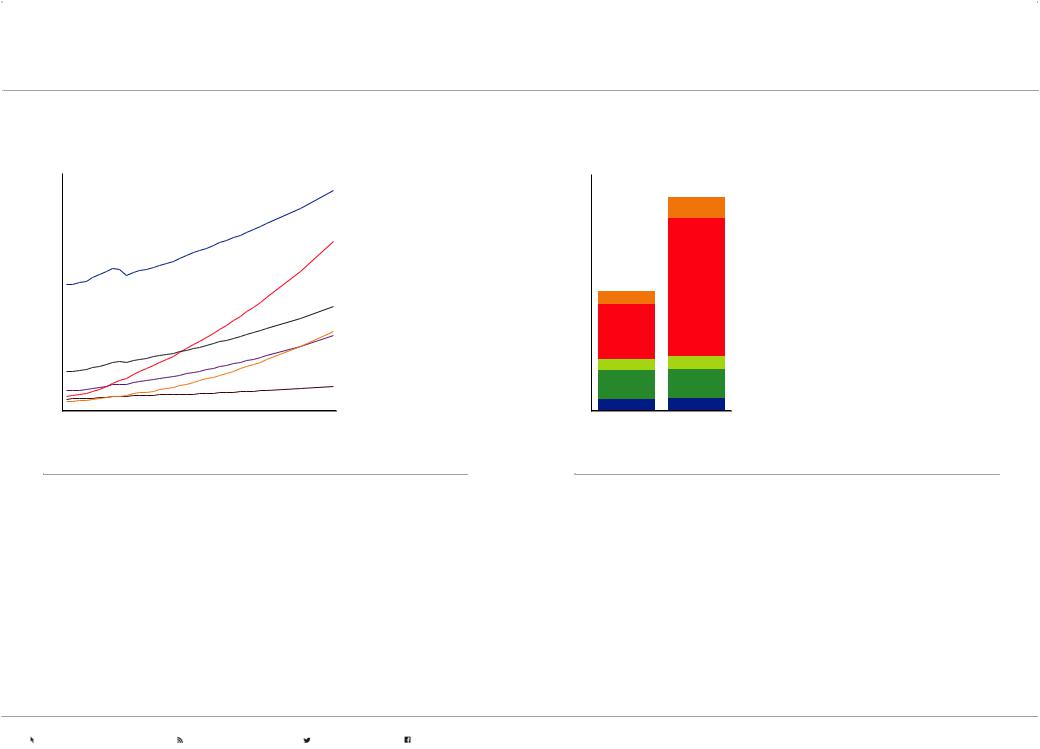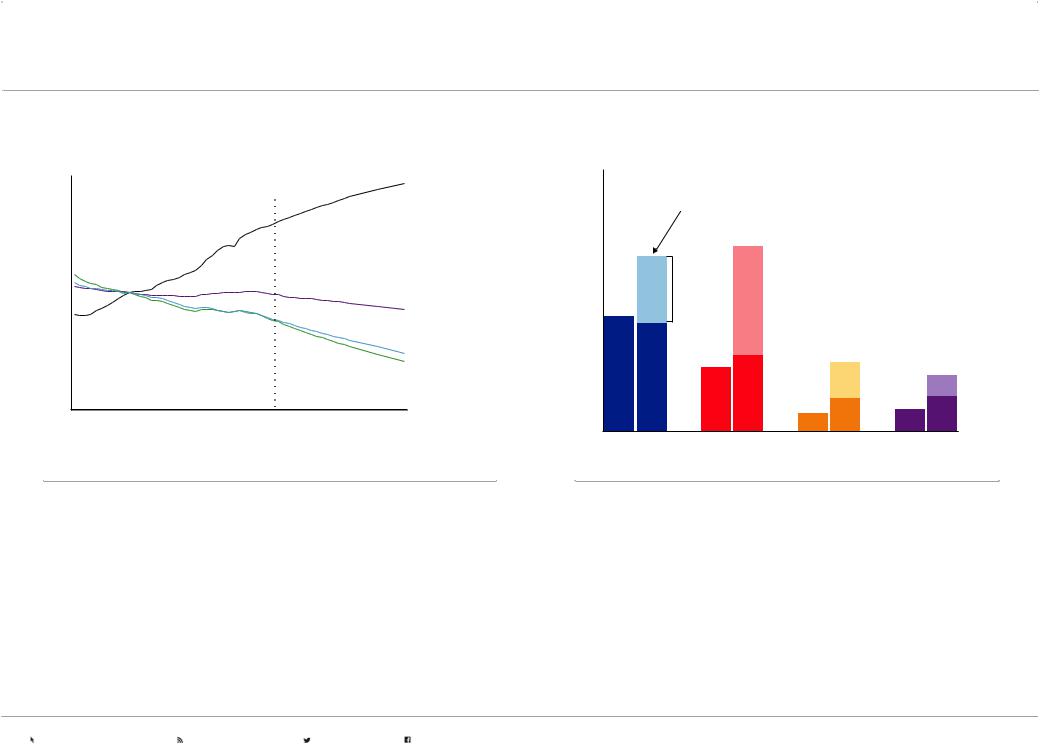
ExxonMobil - Outlook for Energy 2019_watermark
.pdf
vk.com/id446425943

vk.com/id446425943
DUAL CHALLENGE

vk.com/id446425943 |
P.3 |
2019 OUTLOOK FOR ENERGY |
|
|
|
OUTLOOK FOR ENERGY: A PERSPECTIVE TO 2040
The 2019 Outlook for Energy is ExxonMobil’s latest view of energy demand and supply through 2040. For many years the Outlook has helped inform ExxonMobil’s long-term business strategies, investment plans and research programs.
The Dual Challenge
As energy is essential for human development, society faces a dual challenge: to provide reliable and affordable energy to a growing population, while reducing environmental impacts, including the risks of climate change.
A significant portion of the world’s population remains energy-deprived, facing living conditions that would be considered dire by most people in developed countries. Access to modern energy improves a community’s quality of life; it is closely correlated to increased life expectancy, reduced poverty and malnutrition, and higher levels of childhood education.
As growing populations gain increased access to energy, rising living standards in many parts of the world will create the largest expansion of the global middle class in history, meaning more demand for homes, transportation, electricity, consumer goods and the energy to power them all. The challenge is to satisfy this growing demand, while reducing the risks of climate change.
Building a perspective
The Outlook provides a projection of energy demand through 2040 using the International Energy Agency (IEA) and other credible third-party sources as a foundation. The projection is based on likely trends in technology, policy, consumer preferences, geopolitics and economic development. While these individual trends may vary over time, the snapshot provided by the Outlook can help to evaluate society’s progress toward addressing both aspects of the dual challenge.
As these trends evolve, we continue to discuss our approach and conclusions with numerous stakeholder groups, economists and policy experts. The Outlook team also considers various sensitivities and third-party scenarios from peer-reviewed work to improve our understanding of the energy landscape.
Addressing the dual challenge will have ramifications for every nation’s economic, energy security and environmental goals. By sharing our Outlook with the public, we seek to broaden understanding of the world’s energy system and enrich the dialogue on practical, robust solutions.
ExxonMobil supports the Paris Agreement
The Paris Agreement1 on climate change declared governments’ intentions to reduce greenhouse gas (GHG) emissions as outlined in each country’s nationally determined contribution (NDCs). Many states, cities and businesses, including ExxonMobil, expressed support for the aims of the agreement. Our own climate change risk management strategy is described in ExxonMobil’s Energy & Carbon Summary, which can be found at exxonmobil.com.
Based on the Outlook and third-party reports, including the 2018 Emissions Gap Report from the United Nations Environment Programme, we expect that the world is likely to meet, in aggregate, the 2030 Paris Agreement pledges with continued focused efforts, but further work is needed for the world to accelerate progress toward a 2oC pathway.2
Our 2019 Outlook, like the 2018 Outlook, includes a section, “Pursuing a 2oC Pathway”, utilizing third-party, peer-reviewed work coordinated by the Energy Modeling Forum at Stanford University3. The discussion in this section highlights the need for enabling technologies and policies, a role for all primary energy sources, and the continued need for focused investments, including in oil and natural gas.
We believe technology holds the greatest potential to help society address the dual challenge. Technology has already significantly improved energy efficiency and helped to unlock diverse and abundant sources of energy. To address the dual challenge, no technology or energy type can be ignored. Instead, the world must harness a variety of energy sources and technology advances, guided by policies that fully reflect the costs and benefits, consumer preferences and the need to provide affordable energy to all.
Progress toward tackling the dual challenge requires thoughtful and meaningful action by everyone - policymakers, business leaders, technologists and consumers. ExxonMobil is committed to doing our part. As one of the world’s premier energy and technology companies, we are well-positioned to continue providing safe, reliable energy today and effective solutions to meet the word’s future energy needs - all while reducing environmental impacts and mitigating the risks of climate change.
Energy matters to everyone and we all play a role in shaping its future.
Visit exxonmobil.com/energyoutlook |
Subscribe to energyfactor.com |
Follow @exxonmobil |
Follow facebook.com/exxonmobil |

vk.com/id446425943 |
P.4 |
2019 OUTLOOK FOR ENERGY |
|
|
|
KEY TAKEAWAYS OF 2040 PROJECTIONS
Energy is fundamental for modern life
Access to modern energy is intrinsically linked with improvements in quality of life. Over the next few decades, increasing populations and rising prosperity will increase demand for homes, businesses and transportation - and the energy that powers them.
Global energy demand rises by 20 percent; market demand trends differ for OECD and non-OECD
Continued innovation will help OECD economies expand while reducing their energy demand by about 5 percent and energy-related CO2 emissions by nearly 25 percent. In the non-OECD countries however, energy use and emissions will rise along with population growth, increased access to modern energy and improving living standards.
Global electricity demand rises 60 percent
The trend to further electrify buildings, factories, cars and buses, along with smart appliances and greater automation, spurs the need for more electricity everywhere. Solar, wind and natural gas contribute the most to meeting growth in electricity demand.
Almost half of the world’s energy is dedicated to industrial activity
New homes and roads will be constructed and household appliances produced as a result of rising population and urbanization. Steel, cement and chemicals are essential materials to satisfy these needs which, today, are energy-intensive products.
Commerce and trade drive transportation energy consumption up more than 25 percent
Increased on-road efficiency and more electric vehicles will lead to a decline in light-duty vehicle liquid fuel demand. Overall transportation fuel demand growth is driven by increased commercial activity - moving more people and products by bus, rail, plane, truck and marine vessel. Energy-dense, affordable and widely available oil will remain the predominant transportation fuel.
 lobal energy-related CO2 emissions peak, but remain
lobal energy-related CO2 emissions peak, but remain  bove assessed 2oC scenarios
bove assessed 2oC scenarios
 creased energy efficiency and a shift to lower carbon energy sources will help curb CO2 emissions, but not sufficiently to reach a 2oC pathway.2 Innovative technology solutions and supportive policies are still needed to achieve society’s emissions aspirations.
creased energy efficiency and a shift to lower carbon energy sources will help curb CO2 emissions, but not sufficiently to reach a 2oC pathway.2 Innovative technology solutions and supportive policies are still needed to achieve society’s emissions aspirations.
Oil and natural gas remain important energy sources and require significant investment
Oil and natural gas make up about 55 percent of global energy use today. By 2040, 10 of the 13 assessed 2oC scenarios project that oil and gas will continue to supply more than 50 percent of global energy. Investment in oil and natural gas is required to replace natural decline from existing production and to meet future demand under all assessed 2oC scenarios.
Visit exxonmobil.com/energyoutlook |
Subscribe to energyfactor.com |
Follow @exxonmobil |
Follow facebook.com/exxonmobil |

vk.com/id446425943
CONTENTS
4Key takeaways
6Fundamentals
10 Demand
13 Transportation
18 Residential and commercial
20 Industrial
24 Electricity and power generation
28 Supply
30 Liquids
32 Natural gas
37 Emissions
40 Pursuing a 2oC pathway
47Energy matters
48Data
55 Glossary

vk.com/id446425943
FUNDAMENTALS |
productive lives for the growing global population. |
|
Energy is essential for society’s progress. Economic expansion and improving access to energy enable longer, more |
|
|
Society’s progress is intrinsically related to energy. Accesstosafe,reliableandafffordableenergyisisaacriticalenablerofhigherlivingstandards,includingaalongerandhealthierlife..Todayaa significant portion of the global population still faces serious challenges in accessing energy on a daily basis, negatively impacting health and preventing many from fully realizing their potential. The challenges become even greater considering that by 2040 the global population is projected to grow to 9.2 billion from 7.5 billion today.
Improving access to energy and a growing global economy will lead to better economic opportunities, higher incomes and improved living conditions for many. Ascountriesmoveupthe human development index, the improving living standards are associated with increased energy use. Today,almostost50percentoftheglobalpopulationlivesinincountriesthatranklowto medium on the UN’s. .’shumandevelopmentindex. .Advancingdevelopmentforfornearlyhalfhalfthetheworld’spopulationcreatesthethepotentialforforsignificantglobalenergygrowth. .
U.N. 2017
Human
Development
Index
VERY
HIGH
HIGH
MEDIUM
LOW
YEMEN BANGLADESH |
|
INDIA |
|
MEXICO |
|
SPAIN |
|
UNITED STATES |
|
ICELAND |
|
|
|
|
|
||||||
|
|
|
|
|
|
|
|
|
|
|
|
|
|
|
|
|
|
|
|
|
|
|
|
|
|
|
|
|
|
|
|
|
|
|
|
|
|
|
|
|
|
|
|
THE SIZE OF THE CIRCLES DEPICTS
RELATIVE SIZE OF POPULATION
NIGERIA |
EGYPT |
CHINA |
2015 Energy Demand per Capita (1000 BTU/person/day)
10 |
100 |
1000 |
Source U.N. Human Development Reports 2018, World Bank DataBank 2019, EM analyses

vk.com/id446425943 |
P.7 |
2019 OUTLOOK FOR ENERGY | FUNDAMENTALS |
|
|
|
GLOBAL FUNDAMENTALS — PROJECTIONS
World demographics continue to shift
Billions of people
2.5 |
|
|
|
2.0 |
|
|
|
1.5 |
|
|
|
|
|
|
Age |
|
|
|
65+ |
1.0 |
|
|
|
|
|
|
Age |
0.5 |
|
|
15 - 64 |
|
|
|
Age |
0.0 |
'17 '25 |
'40 |
0 - 14 |
|
|
|
OECD |
China |
India |
Other |
Africa Rest of World |
|
|
|
Asia Pacific |
|
|
|
|
Non-OECD |
|
World GDP doubles
Trillions of 2010 dollars |
|
|
||
160 |
|
|
|
|
120 |
|
|
|
|
|
|
|
|
Non-OECD |
80 |
|
|
|
|
40 |
|
|
|
OECD |
0 |
|
|
|
|
2000 |
2010 |
2020 |
2030 |
2040 |
Non-OECD leads growth
Trillions of 2010 dollars GDP 2017-2040 |
|||
50 |
|
4.1% |
|
|
|
||
|
|
CAGR |
|
40 |
|
Other |
|
|
|
Africa |
|
30 |
1.8% |
Other AP |
|
non-OECD |
|||
|
CAGR |
||
|
Other |
India |
|
20 |
|
||
|
|
||
|
Europe |
|
|
10 |
|
China |
|
|
United |
|
|
|
States |
|
|
0 |
|
|
|
OECD Non-OECD
•By 2040, the global population will reach 9.2 billion people, up from 7.5 billion today; India will soon surpass China as the most populous nation, but the most profound growth is in Africa
•Significant increases in prime working-age population in Africa, India and other Asia Pacific (AP) non-OECD countries contribute to the energy needs of these regions
•The rising youth population in Africa and maturing populations in the OECD and China will also influence the future of the global economy and energy demand
•These demographic trends impact global energy markets with geographic shifts in where and how energy is produced, transported and used
•Economic expansion is a key driver of energy demand. World GDP is projected to nearly double from 2017 to 2040 with the non-OECD growing at more than twice the rate of the OECD
•By 2040, the non-OECD countries will account for about half of global GDP, up from about a third today. China and India’s combined growth is nearly the same as the OECD
•The widespread non-OECD economic expansion suggests continued robust demand for energy in these economies
•GDP for the OECD countries grows at a slower pace but from a much higher base than the non-OECD countries.
Visit exxonmobil.com/energyoutlook |
Subscribe to energyfactor.com |
Follow @exxonmobil |
Follow facebook.com/exxonmobil |

vk.com/id446425943 |
P.8 |
2019 OUTLOOK FOR ENERGY | FUNDAMENTALS |
|
|
|
GLOBAL FUNDAMENTALS — PROJECTIONS
Purchasing power expands
GDP per capita – thousands of purchasing power parity dollars
60
OECD
China
40
|
|
|
|
World |
20 |
|
|
|
India |
|
|
|
Other Asia Pacific |
|
|
|
|
|
|
|
|
|
|
Non-OECD |
|
|
|
|
Africa |
0 |
|
|
|
|
2000 |
2010 |
2020 |
2030 |
2040 |
•Access to modern energy enables economic progress and improves quality of life. As income grows, it enables a family to own a home, purchase labor-saving appliances, pursue an education, travel and obtain needed medical treatment
•As GDP grows faster than population around the globe, average personal incomes rise everywhere, albeit with significant country and regional variations
•By 2040, China GDP per capita is expected to triple and be at about 75 percent of the OECD
•Over the Outlook period, India per capita GDP level is likely to grow even faster than China, but remaining below the global average. Africa only achieves an average 50 percent increase
Middle class almost doubles
Global middle class – billions of people 6
|
Africa/Middle East |
5 |
|
4 |
Asia Pacific |
|
|
3 |
|
2 |
|
|
Latin America |
1 |
|
|
Europe |
0 |
North America |
|
|
2015 |
2030 |
Source: The Brookings Institution - Global Economy & Development 2017
•Even though the average income in the non-OECD countries remains lower than in the OECD, there is already a burgeoning middle class that can afford more than the basic necessities of food and shelter. The Brookings Institution foresees continued rapid growth of the global middle class, with billions more people rising out of poverty by 2030
•Asia Pacific represents the largest growth, with India and China each expected to have more than 1 billion middle-class citizens by 2030
•The expanding middle class means billions of people will aim to improve their living conditions and access to energy is a critical enabler for these aspirations
Visit exxonmobil.com/energyoutlook |
Subscribe to energyfactor.com |
Follow @exxonmobil |
Follow facebook.com/exxonmobil |

vk.com/id446425943 |
P.9 |
2019 OUTLOOK FOR ENERGY | FUNDAMENTALS |
|
|
|
GLOBAL FUNDAMENTALS — PROJECTIONS
Technology enables energy efficiency
Index, 1990=100 |
|
|
|
|
|
|
200 |
|
|
|
|
|
Energy demand |
|
|
|
|
2017 |
|
|
150 |
|
|
|
|
|
|
100 |
|
|
|
|
|
|
|
|
|
|
|
|
CO2 per unit of energy |
50 |
|
|
|
|
|
Energy per unit of GDP |
|
|
|
|
|
|
CO2 per unit of GDP |
0 |
|
|
|
|
|
|
1980 |
1990 |
2000 |
2010 |
2020 |
2030 |
2040 |
•Technology advances and choices by consumers and businesses to use energy more efficiently can moderate growth in energy demand even as the economy expands
•Energy intensity measures the amount of energy used to produce a unit of GDP. Global energy intensity is expected to improve at nearly 2 percent per year from 2017 to 2040, more than double the pace of improvement from 2000 to 2017
•Meanwhile, the carbon intensity of energy (energy-related CO2 emissions per unit of energy consumed) is also expected to trend down as policies drive efficiency and aim for a lower-carbon energy mix in pursuit of national climate policy goals
•By 2040 the combined effects of lower energy intensity and less carbon-intensive energy sources result in a nearly 45 percent reduction in the carbon intensity of the global economy (tonnes energy-related CO2 emissions per unit of GDP)
Global efficiency limits demand growth
Energy demand – quadrillion British thermal units (BTUs) 500
Potential demand without energy efficiency
400 |
|
|
|
|
300 |
|
Energy |
|
|
|
|
efficiency |
|
|
200 |
|
|
|
|
100 |
|
|
|
|
'17 |
'40 |
|
|
|
0 |
|
|
|
|
OECD |
China |
India |
Other Asia |
|
|
|
|
|
Pacific Non- |
Energy efficiency based on constant GDP intensity for the country/region |
OECD |
|||
•Hypothetically, if energy intensity remained the same over time, global energy demand would grow in lock step with GDP, almost doubling between 2017 and 2040
•However, global energy demand is projected to grow only by about 20 percent from 2017 to 2040 because continued efficiency improvement lowers the energy intensity of the global economy
•OECD demand is expected to decline about 5 percent from 2017 to 2040 despite about 50 percent GPD growth as efficiency more than offsets the underlying growth drivers
•All of the projected energy demand growth is expected to be from the non-OECD countries, led by China and India. There, the implied energy savings are not enough to offset the inherent demand growth driven by population and economic growth
Visit exxonmobil.com/energyoutlook |
Subscribe to energyfactor.com |
Follow @exxonmobil |
Follow facebook.com/exxonmobil |

vk.com/id446425943
DEMAND:
THREE DRIVERS
TECHNOLOGY: Deploying new technology allows society to do more with less. Most successful technologies often have the supporting policy and commercial frameworks to achieve scale. AApolicy,liketaxincentives,canspurdevelopmentofnew technology, but these technologies ultimately need to compete without subsidies to reach a large enough scale to impact global markets. Consumer preferences can also create a “"pull effect"” that increases demand in the marketplace for new technologies.
Policy. Technology. Consumer preferences. All three impact how the world uses energy. Each driver influences the other. The interplay between these can vary depending on local circumstances (available resources, public support) and can change over time. At ExxonMobil, we’re continually studying energy demand and developing models that measure its potential impact — all in an effort to gain a deeper understanding of the interconnectivity of the global energy system.
TECHNOLOGY
>>
POLICY: Shifts in policy can stimulate new technology and influence consumer choices.
For example, policies can encourage adoption of new technology (free parking for electric vehicles) or discourage the use of an existing technology (restrictions on coalbased power). Thecorolllaryisisalsotrue: policy not enabled by competitive technology or not aligned with consumer preferences can be difficult to implement because it is hard to mandate something that isn’t better than current options in the eyes of the consumer.
DEMAND
>> |
>> |
POLICY |
CONSUMER |
|
PREFERENCES |
||
|
CONSUMER PREFERENCES:
Demand for energy begins with the numerous choices consumers make in their daily lives. These preferences can shift as new technology enables options that better meet a consumer's’ needs, such as llower energy costs and lower emissions.
Consumer preferences can also be altered over time by policies that incentivize choices, like a carbon tax that encourages more lower carbon electricity supply.
Visit exxonmobil.com/energyoutlook |
Subscribe to energyfactor.com |
Follow @exxonmobil |
Follow facebook.com/exxonmobil |
